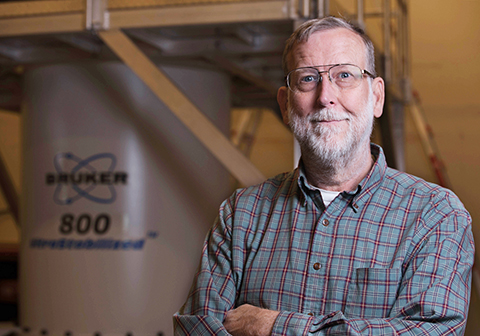January 13, 2016
Did You Know?: Purdue Interdepartmental NMR Facility
 |
|
Jerry Hirschinger, instrumentation specialist for the Purdue Interdepartmental NMR (Nuclear Magnetic Resonance) Facility, stands in front of one of the three NMR magnets in Brown Laboratory of Chemistry. (Purdue University photo/Brooklyn Gingerich) |
Deep in the bowels of the Brown Laboratory of Chemistry are three magnets with internal field strengths of up to 380,000 times that of Earth's magnetic field at the surface. These magnets (the largest standing almost two stories tall) as well as four in Wetherill Laboratory of Chemistry, two in Heine Pharmacy Building, and one in Drug Discovery Research Facility, make up the Purdue Interdepartmental NMR (Nuclear Magnetic Resonance) Facility.
The facility is used by researchers in the Department of Chemistry, the Department of Biological Sciences, the College of Pharmacy, the Purdue Center for Cancer Research, and more to determine the physical structure of a given molecule and the arrangement of atoms within it.
"We're an interdepartmental facility because the instruments are so expensive that one research group is not likely to be able to afford them, let alone operate them," says Jerry Hirschinger, the facility's instrumentation specialist. "So, we pool resources in order to buy these big instruments, and researchers pay for the time that they use the instruments."
The magnets are needed in order to take advantage of the resonating spin of the nucleus of an atom so that information about the molecule can be gathered. The best way to understand this phenomenon is a simple as tightening a guitar string, Hirschinger says.
"If you tighten the string, you make it resonate at a higher frequency," he says, plucking at a guitar he often uses for demonstrations. "It's the same thing with a nucleus in an atom. If you put it in a higher magnetic field, it spins at a higher frequency."
When the magnets spin nuclei at radio frequencies, they can be manipulated using radio transmissions and send signals to radio receivers. The interaction of the signals gives insight as to the structure of the molecule and the lengths of the bonds between atoms of a molecule.
These technologies allow researchers to confirm, according to the spectroscopic data, what type of changes they've made to a molecule or what types of changes they wish to make. The facility has a user base of about 300 people across campus, the vast majority of them being graduate students and postdoctoral researchers who have been trained to use the machines and services. However, John Harwood, the facility director, emphasized that use of the facility is not limited to any particular groups.
"In some other departments, like engineering, food science, etc., they sometimes have a need for NMR, but they don't necessarily need it every week," Harwood says. "For those people, we do provide service."
Hirschinger says that since NMR is a common chemistry research tool, the facility is not something that is unique to Purdue. However, the fact that Purdue built the space for these machines -- before some of them even existed -- has greatly benefited the facility and corresponding research.
"When they built Brown Laboratory in 1972, they had no idea what kind of instruments they were going to have," Hirschinger says. "But they knew some of them were going to be big. Without that foresight we would need a new building to have NMRs this large."
Writer: Anna Schultz, 812-447-5229, schult70@purdue.edu

